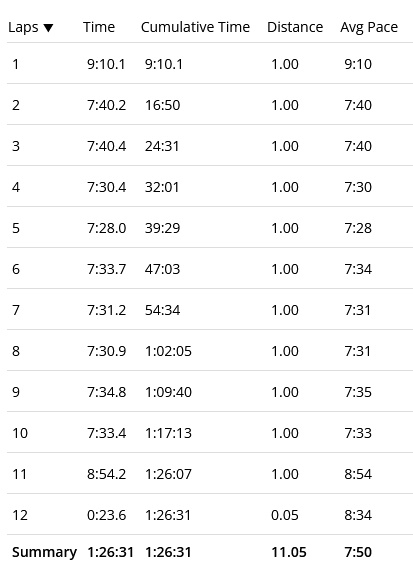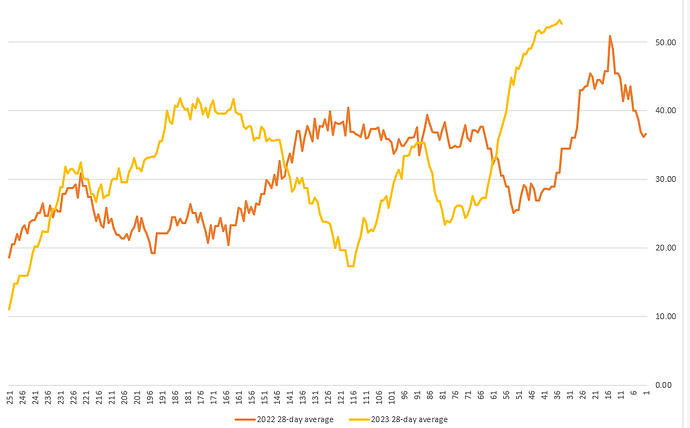10sec eccentric seems insane. I know that kind of thing can be useful for treating tendinopathy and similar issues, but I’m not sure how much benefit it provides to a healthy trainee other than making every set hell.
It doesn’t really. It’s a little unpleasant but you get used to it. I don’t know if it’s good or not either.
I guess it depends on the weight. I know that when it’s time to do slow tempo reps of leg press/extension/box squat to rehab my patellar tendon (usually 6-8RM range), I pretty much would rather jump off a bridge. And I’m just doing them with 3s tempo on both the concentric and eccentric with a 1s pause in between.
Reading that link it seems like the author takes it for granted that more sets are more beneficial. But he also thinks that a single set of 3 rir would be less beneficial than a single set to failure. But he’s saying you can do three sets of 3 rir, which sure is maybe true. It’s not obvious that’s better though.
By keeping reps in the tank, not only are you able to perform more total work per session, but it’s far easier to recover from between workouts and thus allows you to train more frequently, helping drive long term progress more efficiently. A person doing 20 sets of chest per week who leaves reps in the tank will make steady progress without risk of recovery issues or injury, while a person attempting to perform 20 sets of chest to failure will dig themselves into a recovery rut within a two week period (probably less) and begin to stall or get injured, requiring valuable time off from the gym in order to recover.
What about someone who does 20 sets of chest per week versus someone who’s doing one set per week? Obviously 20 sets to failure per week is insane and no one would ever do that.
That’s a fair point. I’ve seen other stuff indicating 3-5 sets per exercise is ideal, but there are so many variables they could be wrong. If you are doing 10 seconds each eccentric, on set may be more than enough.
I know I definitely recover quicker and feel less sore the next day once I switched to doing 3 sets leaving a few RIR rather than always doing last set to failure.
So the doc checked out my 65 year old really sore left knee and determined it was most likely a flare-up of arthritis. The steroid pack he prescribed seems to be helping as the soreness has decreased pretty dramatically. This is the first big unexplained joint issue that I’ve had, but I’m glad it’s nothing worse. Having these things happen every once in a while makes me feel so much more grateful when I get back to feeling 100%.
Anybody have experience dealing with plantar fascitis?
It’s kinda weird. I had zero pain when traveling abroad. Yet at home, I have it. Then it goes away as the day progresses.
Yeah one of the reasons I cut my planned drive to South America off at Panama was plantar fasciitis, compounded by a heel spur. When I got back to LA I just walked, hiked and did a lot of calf stretches, and eventually it went away.
Everyone seems to think they have a miracle cure, but it could be that it just goes away with time. I think my left leg being curled up while I was doing all that driving didn’t help matters. I also never wear flip flops anymore.
Don’t have it, but as a measure to avoid it and other foot ailments I’ve been using one of these, which are prevalent in Japan (where everyone walks a ton), for decades.
Roughly 5 weeks out from the marathon and August 2023 goes in the books as my highest mileage month ever, by far. Assuming I’m tracking things right, I logged 227 miles. Over the last 6 weeks (since I got back from Europe), I’m averaging just under 50 miles a week.
As I mentioned earlier, I stepped into the Hansons beginner plan midway through (like week 7 out of 18), due to a 2 week trip to Europe. But I think I’ve done every scheduled run since then. The plan is completely different from how I’ve historically (under)trained for marathons. In the past, I’d do some half-assed amount of runs during the week and focus entirely on making sure I did one long run each week, making sure that I hit at least one 18- or 20-mile long run at some point.
This Hanson plan not only has me doing higher overall mileage, but is very different in two dimensions:
- The longest long run is 16 miles
- Midweek runs are tough
The general idea is that it’s cumulative mileage/fatigue that matters, not the once-a-week long run. I still have a lot of skepticism about this, but there’s no doubt that the tough midweek runs are benefitting me.
This week’s schedule:
Monday: 7 miles easy pace
Tuesday: 1.5 mile warm-up, 3 x 2 miles at 10 seconds faster than marathon pace with .5 mile jogging rest, 1.5 mile cool down
Wednesday: off
Thursday: 1 mile warm-up, 9 miles at marathon pace, 1 mile cool down
Friday: 6 miles easy pace
Saturday: 6 miles easy pace
Sunday: 16 mile long run
I still haven’t dialed in my goal marathon pace, but I’ve felt comfortable for the last few weeks in the general area of 7:40-8:00. Every Tuesday and Thursday (the hard speed days), I look at the scheduled workout and think, “my god, I’m so tired, I don’t think I have it in me today”. And yet it’s turned out fine each time, knock on wood.
Today:
This was a hard run, but I don’t feel completely wiped out, and I expect that I’ll be perfectly able to do the scheduled 6 miles tomorrow. This kind of marathon-paced run was definitely not something that was a part of my prior marathon attempts.
So at this point, I’m firmly in the camp that believes (knows) that you really need high mileage to do well in a marathon. I’m happy with the mileage I’ve built up recently, but I realize that I’m still not in great shape for the upcoming race, considering:
- I’m probably still running the hard days a little too fast
- More importantly, I won’t have nearly enough months of high mileage under my belt
That being said, I’m hoping a PR is a possibility, which is something I never would have guessed 2-3 months ago.
I’m doing a “baby” Hanson plan from their “First Marathon” book, but I think it has some similarities to what you’re doing. Today was a speed day with 4x1200m at 10k pace. I was happy to hit my paces since I had two failed workouts last week. (I also might have been a little sick.)
Will do a 14m run this weekend.
This last post was kind of, “Hey, everything is going great; I am on track for a good marathon”. So I thought I’d update with the results from today: I completely bonked on today’s scheduled 16 mile run, and it’s clear that I am not, in fact, on track for a good marathon.
After the first 12 miles in the 9:00-9:10 range, I just ran out of steam/energy/whatever, and basically did a walk/shuffle for the rest. Part of this was temperature/humidity, as it was over 80 degrees and humid. Also insufficient fueling before/during the run. But most importantly, I think I still don’t have a long enough series of high-volume weeks to be feeling very confident. I’m already feeling very worried about this plan’s lack of >16 mile runs, and if I can’t even hit those 16 mile runs, then hooooooo boy I’m in trouble.
What is your longest training run before your race? Are you doing 18 and then a 20?
I wouldn’t get down on yourself especially if this your first marathon you are training for.
I remember my first 20 mile training run was on a day that was hotter and more humid that race day and I thought I was going to die.
The race was a lot easier since I dealt with that adversity in training
he has run one and posted about it upthread
Longest training run is 16 miles. This is the most controversial aspect of the Hanson marathon method.
This is my 7th. But the first 4 were in 1998-2001, so are basically irrelevant. Latter 2 were in 2016 (3:44?) and 2022 (3:33).
I’m trying to balance my feelings on this one. There’s no getting around the fact that yesterday was a failed run. But I think weather and fueling played large parts in that, so there’s really nothing for me to do but act as if everything is fine and keep on the schedule. Today was an easy 5 miles and it felt fine. Tomorrow is a hard workout (10 miles with 6 of them at sub-marathon pace); hopefully that will be ok, too.
What’s causing me a lot of anxiety is the battle between cumulative mileage and the long run. This year, I’ll be going into the race (knock on wood) with substantially more volume in the last 10 weeks than I did last year. The question is, will that compensate for the fact that last year had a few long runs of 20 miles or more?
I’m keeping track of my mileage before this year’s race (yellow) relative to last year’s race (orange). Each point is the day relative to race day (so yellow is incomplete, since I’m still 5 weeks out), and is equal to the average weekly volume over the prior 28 days. I’ll be going into this year’s race with about 10 weeks averaging more than 50 miles per week. Last year I hit a 50 mile average over four weeks at only a single point. (The dip in last year starting at day -65 was me getting hit with a bad case of COVID. The two dips this year were me getting a blood clot in my leg after an international trip and then a 2-week trip to Europe with lots of walking but virtually no running.)
It was really dumb of me to try to do a serious program for this year’s race, since I knew that there would be a big Europe trip in the middle of it, and doubly so after I got that dumbass (but scary) blood clot. Yet here I am, spending countless hours worrying and wondering about my preparation, and making stupid spreadsheets as if that’s going to be any help.
Do you have a specific goal time in mind for race day?
Probably realistic goal: 3:40
Possibly realistic goal: 3:33
Unrealistic goal: 3:25
Given the shit weather of your last one, I think unrealistic goal isn’t that unrealistic.
PR from 20 yrs ago?
Weather last year was truly nuts. But it wasn’t hot. A warm early October day is definitely possible (and would be bad).
PR from 20 years ago was like 3:43. It was back when I had a pretty inflexible job and my “training” was even more haphazard than it’s been recently.
I’m taking the under on 3:33.
Good luck!

